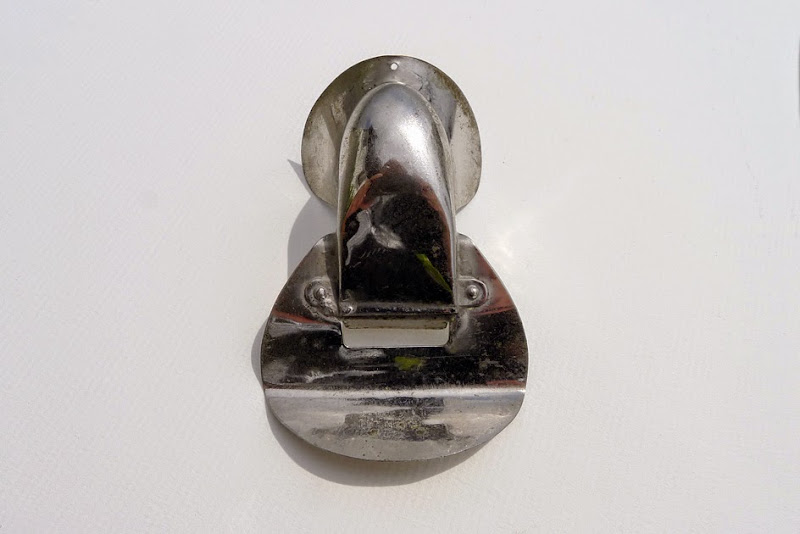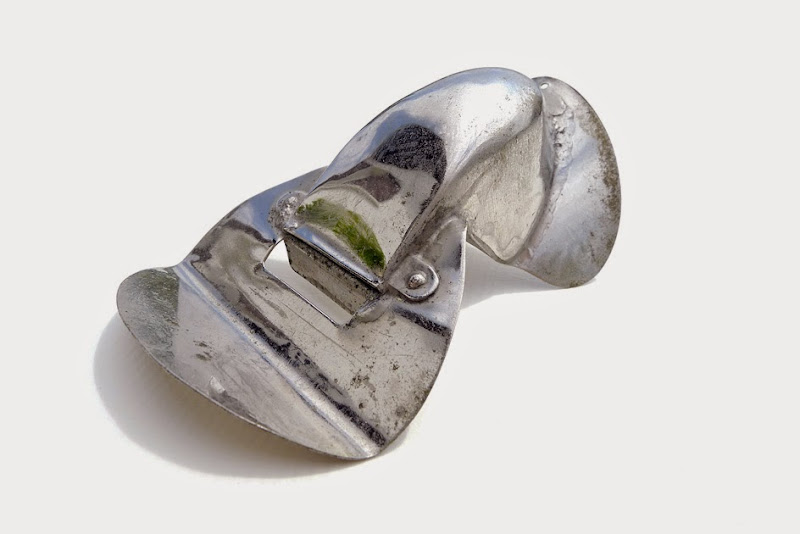In a
previous post, we began to analyse what would be the best acoustic model to be applied to nose flutes. The simplest model was provided by Mr. David Lapp, physics teacher, who published his study (available
here), with a part devoted to the nose flute. The model used assimilates the nose flute to a closed pipe, which resonator (the mouth) is simplified to a (variable capacity) tube shape. The prediction of a frequency, depending on the volume of the mouth, is therefore the result of the equation
F = v/4L. My experiments shown that the simplifications operated on the model lead to wrong results (in the proportion of 1 to 3!).
Thanks to our friend and Jew's harp expert Harm Linsen, I was driven to the reading of a 2010 Master thesis in Traditional Arts, produced by Mr. Sylvain Trias at Telemark University College:
Helmholtz & coupled resonators acoustics in jew's harp playing (click on its title for a download).
This work deals with jew's harp, which is the other instrument that works as the nose flute: the pitch is driven by the mouth cavity size, with an external vibration production. Thus, the acoustic model used for the nose flute should be the same than for the ancient lamellophone: a Helmholtz resonator.
Helmholtz resonators:


The Helmholtz resonator is a simple apparatus: a sphere with a neck, and the Helmholtz resonance is the acoustic phenomenon that occurs when someone make a sound when blowing in a bottle. Hermann Helmholtz set up the equation predicting the frequency of the sound produced when blowing in the resonator. This frequency depends on the sphere volume, but also the dimensions of the neck.
I had the opportunity to have a chat with Sylvain Trias (very kind person!) to whom I wanted to ask if the Helmholtz resonator was the right model for the nose flutes. Mr. Trias confessed he didn't know much the nose flute and asked me if I could provide spectrograms. I bought a $3 spectrographic app, and produced 3 spectra: a glissando from the sharpest to the lowest note I can produce with a Bocarina
™, the lowest note held during some seconds, and an extract of
Queen of the Night:

Sylvain Trias confirmed the Helmholtz resonator is the right model for the nose flute, adding (sorry, it's a bit serious):
« Tu peux voir page 14 qu'il est possible de moduler avec la cavité de Helmholtz des frequences proches de 500Hz. Cela signifie tout de même avoir le larynx dans une position extrèmement haute (p89). Au pire, vu les spectres au dessus, tu auras juste un renforcement possible du volume des frequences basses de ton jeu comme illustré par le graphique p76. Rien qui ne soit remarquable devant les changements de volume liés aux variations de ton souffle. Les modulations sont bien dues au changement de volume de la cavité resonnante avant. Cela est aussi confirmé par la bande des frequences que tu produits qui est la même que celle de la mélodie d'une guimbarde - les limites étant physiologiques. »
that is:
« You can see on page 14 that it is possible to modulate frequencies around 500Hz with the Helmholtz cavity. This means still have the larynx in an extremely high position (p89). At worst, given the spectra above, you just get a possible strengthening of the volume of low frequency of your playing, as illustrated by the graph p76. Nothing that is not noticeable regarding to volume changes associated with breath variations. The modulations are really due to the change of volume of the front resonant cavity. This is also confirmed by the band of frequencies that you produce which is the same as the melody of a Jew's harp - the limits are physiological. »

Well... the equation to predict the frequency for a Helmoltz resonator is built from the resonator measurements and "c", the speed of sound. So, I decided to measure (estimate) the parameters l1, l2, A1 and A2 for my mouth. I found around 7 cm for my mouth in depth while shaping it as I do when I reach my lowest note on the nose flute (having reduced the measure of the lips depth), and estimated to 1 cm the lips depth. The measurement of the mouth section was more tricky, but I estimated (as Mr. Trias did) at 9 cm2. The trickiest part was to estimate the surface of the small opening between the lips. Mr. trias used 1 cm2 in his calculation, but remember that when playing the Jew's harp, you can't close the lips as tight as you can with a nose flute, because the lamella has to be able to vibrate in between. I estimated my opening when reaching the lowest note at 0.25cm2. Finally, having made my experiment at around 20°C (68°F), I chose 343m/s for the speed of sound (that is 34300 cm/s, since I used centimeters as a unit).
A1 : 9 cm2
A2 : 0.25 cm2
l1 : 7 cm
l2 : 1 cm
c : 34300 cm/s
F = c/2π*SQR(A2/(A1*l1*l2) = (34300/(2*3.1416))*SQR(0.25/(9*7*1)) = 343.88 Hz
This result is incredibly accurate in comparison with my experiment (remember that
I measured 347 Hz), and it is a great piece of luck since modifying just a little bit the parameters leads to very different results. Anyway, this result
*does not invalidate* the Helmholtz model, contrarywise to the "slide whistle model" David Lapp used. This globally means that the lips forming a "neck" to the "bottle" of our mouth are very important in the pitching of the note (and dramatically impacts the model).
--
Accurate or not were my measurements and estimations, the calculations can provide anyway
relative info. For instance, what happens when "c" evolves? Indeed, the speed of sound is not the same when the weather is cold or hot, and also depends on the altitude.
With the same mouth measurements, if I tried reaching this lowest note on the top of Mount Fuji (3776 m), the speed of sound would be 325 m/s, and my lowest note at 325.84 Hz, which is more than 5% lower, and represents a semitone (F4 at 349.2 Hz and E4 at 329.6 Hz).
Contrarywise, if I joined Mr Schuermans in South Africa on a very hot Winter day, with a 40°C (104°F) air temperature, the speed of sound would be around 355 m/s. My lowest note would be a 355.92 Hz sound, between a F4 and a F#4.
If all my dimensions were 10% larger (big head!), instead of my 347 Hz, I'd get a nice 312.62 HZ D#4, etc.

































